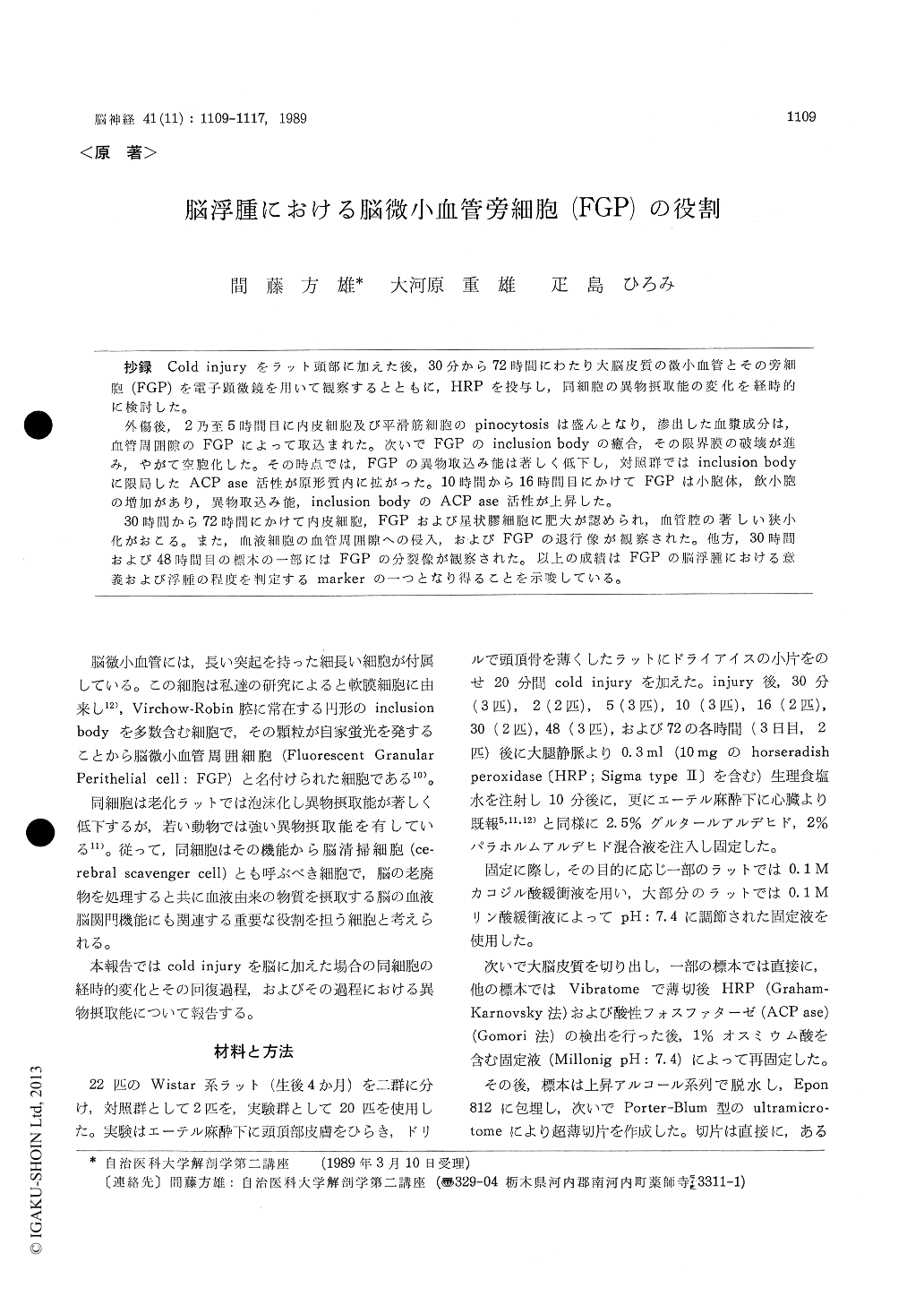Japanese
English
- 有料閲覧
- Abstract 文献概要
- 1ページ目 Look Inside
抄録 Cold injuryをラット頭部に加えた後,30分から72時間にわたり大脳皮質の微小血管とその旁細胞(FGP)を電子顕微鏡を用いて観察するとともに,HRPを投与し,同細胞の異物摂取能の変化を経時的に検討した。
外傷後,2乃至5時間目に内皮細胞及び平滑筋細胞のpinocytosisは盛んとなり,滲出した血漿成分は,血管周囲隙のFGPによって取込まれた。次いでFGPのinclusion bodyの癒合,その限界膜の破壊が進み,やがて空胞化した。その時点では,FGPの異物取込み能は著しく低下し,対照群ではinclusion bodyに限局したACP ase活性が原形質内に拡がった。10時間から16時間目にかけてFGPは小胞体,飲小胞の増加があり,異物取込み能,inclusion bodyのACP ase活性が上昇した。
30時間から72時間にかけて内皮細胞,FGPおよび星状膠細胞に肥大が認められ,血管腔の著しい狭小化がおこる。また,血液細胞の血管周開隙への侵入,およびFGPの退行像が観察された。他方,30時間および48時間目の標本の一部にはFGPの分裂像が観察された。以上の成績はFGPの脳浮腫における意義および浮腫の程度を判定するmarkerの一つとなり得ることを示唆している。
Small cerebral blood vessels are provided with slender phagocytic cells which were designated as FGP (fluorescent granular perithelial) cells from their localization and property. They were derived from pial cells and became potent in theuptake capacity for exogenous substance about at one week after birth. The present study aims to confirm the role of FGP cells and to clarify morphological changes of them in cerebral edema.
Cerebral cortices of Wistar rats received head injury (caused with dry ice) were studied electron microscopically at O. 5, 2, 5, 10, 16, 30, 48 and 72 hours after the injury. At the same interval, HRP (horseradish peroxidase) was injected intra-venously for the demonstration of uptake capacity of FGP cells.
The authors' attention focussed on the change of ultrastructure of vascular wall including peri-vascular phagocytic FGP cell around small blood vessels and on the uptake capacity of FGP cells at each time.
From 2 to 5 hours after the cold injury, pinoc-ytotic vesicles often appeared in endothelium and smooth muscle cells, and blood plasma infiltrated into the perivascular space and was taken in the FGP cells.
The FGP cells in control were provided with intense round inclusion bodies and looked mode-rately intense. However, the FGP cells in the ex-perimental animals after the injury became swol-len and vacuolized following the fusion of inclu-sion bodies and breakdown of their limiting me-mbrane and looked pale owing to presence of va-cuoles. Under this condition, the uptake capacity of FGP cells for HRP decreased remarkably, and ACPase which was confined to the inclusion bo-dies in controls spread diffusely into cytoplasm. Mitochondria were occasionally swollen.
From 10 to 16 hours, mitochondria took definite forms, and endoplasmic reticula and vesicles in the FGP cells increased gradually. ACPase acti-vity in inclusion bodies tended to recover.
From 30 to 72 hours, endothelium, FGP cells and astrocytes became swollen and the vascular lumina became narrow. Fibroblastoid FGP cells which were rich in rough surfaced endoplasmic reticulum appeared around blood vessels.
During this period, blood cells extravasated into the perivascular space and were clustered between vascular wall and FGP cells. The degeneration of FGP cells occurred occasionally at the early stage of cerebral edema and mitosis of FGP cell was obse-rved in the specimens obtained at 30 and 48 hours.
From these evidences mentioned above, it is sug-gested that the FGP cells change their shape and contents in response to head injury and take an important role for digestion of blood plasma and degenerating substance in cerebral edema. They are also regarded as one of morphological markers of cerebral edema.

Copyright © 1989, Igaku-Shoin Ltd. All rights reserved.


